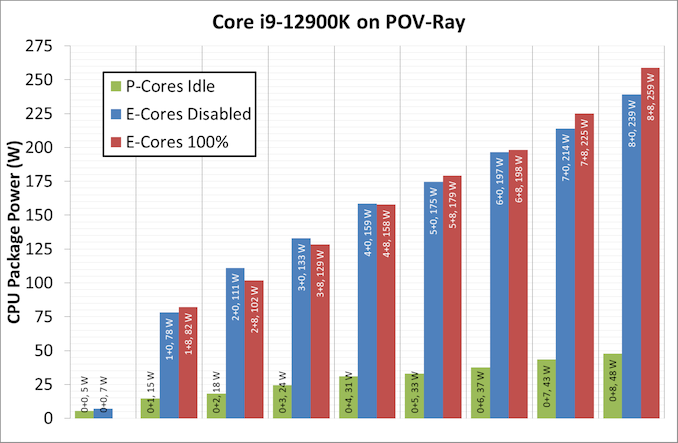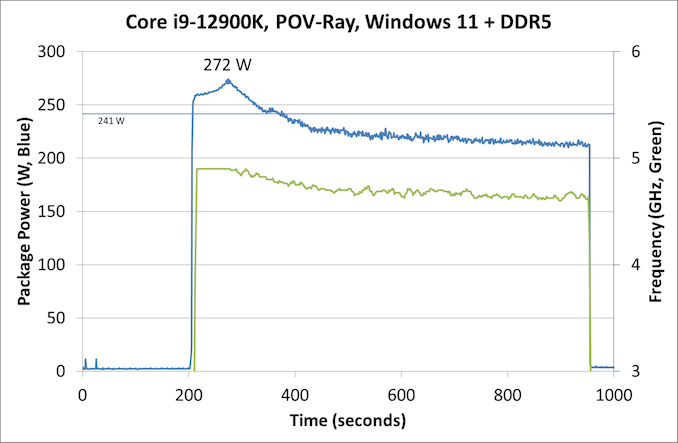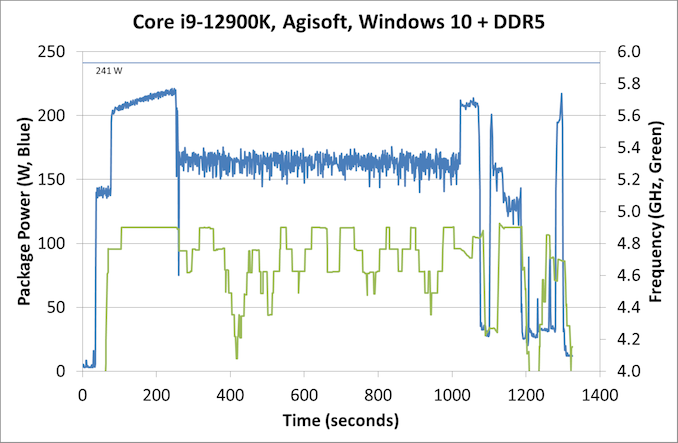The Intel 12th Gen Core i9-12900K Review: Hybrid Performance Brings Hybrid Complexity
by Dr. Ian Cutress & Andrei Frumusanu on November 4, 2021 9:00 AM ESTPower: P-Core vs E-Core, Win10 vs Win11
For Alder Lake, Intel brings two new things into the mix when we start talking about power.
First is what we’ve already talked about, the new P-core and E-core, each with different levels of performance per watt and targeted at different sorts of workloads. While the P-cores are expected to mimic previous generations of Intel processors, the E-cores should offer an interesting look into how low power operation might work on these systems and in future mobile systems.
The second element is how Intel is describing power. Rather than simply quote a ‘TDP’, or Thermal Design Power, Intel has decided (with much rejoicing) to start putting two numbers next to each processor, one for the base processor power and one for maximum turbo processor power, which we’ll call Base and Turbo. The idea is that the Base power mimics the TDP value we had before – it’s the power at which the all-core base frequency is guaranteed to. The Turbo power indicates the highest power level that should be observed in normal power virus (usually defined as something causing 90-95% of the CPU to continually switch) situation. There is usually a weighted time factor that limits how long a processor can remain in its Turbo state for slowly reeling back, but for the K processors Intel has made that time factor effectively infinite – with the right cooling, these processors should be able to use their Turbo power all day, all week, and all year.
So with that in mind, let’s start simply looking at the individual P-cores and E-cores.
Listed in red, in this test, all 8P+8E cores fully loaded (on DDR5), we get a CPU package power of 259 W. The progression from idle to load is steady, although there is a big jump from idle to single core. When one core is loaded, we go from 7 W to 78 W, which is a big 71 W jump. Because this is package power (the output for core power had some issues), this does include firing up the ring, the L3 cache, and the DRAM controller, but even if that makes 20% of the difference, we’re still looking at ~55-60 W enabled for a single core. By comparison, for our single thread SPEC power testing on Linux, we see a more modest 25-30W per core, which we put down to POV-Ray’s instruction density.
By contrast, in green, the E-cores only jump from 5 W to 15 W when a single core is active, and that is the same number as we see on SPEC power testing. Using all the E-cores, at 3.9 GHz, brings the package power up to 48 W total.
It is worth noting that there are differences between the blue bars (P-cores only) and the red bars (all cores, with E-cores loaded all the time), and that sometimes the blue bar consumes more power than the red bar. Our blue bar tests were done with E-cores disabled in the BIOS, which means that there might be more leeway in balancing a workload across a smaller number of cores, allowing for higher power. However as everything ramps up, the advantage swings the other way it seems. It’s a bit odd to see this behavior.
Moving on to individual testing, and here’s a look at a power trace of POV-Ray in Windows 11:
Here we’re seeing a higher spike in power, up to 272 W now, with the system at 4.9 GHz all-core. Interestingly enough, we see a decrease of power through the 241 W Turbo Power limit, and it settles around 225 W, with the reported frequency actually dropping to between 4.7-4.8 GHz instead. Technically this all-core is meant to take into account some of the E-cores, so this might be a case of the workload distributing itself and finding the best performance/power point when it comes to instruction mix, cache mix, and IO requirements. However, it takes a good 3-5 minutes to get there, if that’s the case.
Intrigued by this, I looked at how some of our other tests did between different operating systems. Enter Agisoft:
Between Windows 10 and Windows 11, the traces look near identical. The actual run time was 5 seconds faster on Windows 11 out of 20 minutes, so 0.4% faster, which we would consider run-to-run variation. The peaks and spikes look barely higher in Windows 11, and the frequency trace in Windows 11 looks a little more consistent, but overall they’re practically the same.
For our usual power graphs, we get something like this, and we’ll also add in the AVX-512 numbers from that page:

Compared to Intel’s previous 11th Generation Processor, the Alder Lake Core i9 uses more power during AVX2, but is actually lower in AVX-512. The difficulty of presenting this graph in the future is based on those E-cores; they're more efficient, and as you’ll see in the results later. Even on AVX-512, Alder Lake pulls out a performance lead using 50 W fewer than 11th Gen.
When we compare it to AMD however, with that 142 W PPT limit that AMD has, Intel is often trailing at a 20-70 W deficit when we’re looking at full load efficiency. That being said, Intel is likely going to argue that in mixed workloads, such as two software programs running where something is on the E-cores, it wants to be the more efficient design.














474 Comments
View All Comments
Spunjji - Friday, November 5, 2021 - link
N7 is a little more dense than Intel's 10nm-class process - 15-20% in comparable product lines (e.g. Renoir vs. Ice Lake, Lakefield vs. Zen 3 compute chiplet). There is no indication that Intel 7 is more dense than previous iterations of 10nm. N7 also appears to have better power characteristics.It's difficult to tell, though, because Intel are pushing much harder on clock speeds than AMD and have a wider core design, both of which would increase power draw even on an identical process.
Blastdoor - Thursday, November 4, 2021 - link
I’m a little surprised by the low level of attention to performance/watt in this review. ArsTechnica gave a bit more info in that regard, and Alder Lake looks terrible on performance/watt.If Intel had achieved this performance with similar efficiency to AMD I would have bought Intel stock today.
But the efficiency numbers here are truly awful. I can see why this is being released as an enthusiast desktop processor -- that's the market where performance/watt matters least. In the mobile and data center markets (ie, the Big markets), these efficiency numbers are deal breakers. AMD appears to have nothing to fear from Intel in the markets that matter most.
meacupla - Thursday, November 4, 2021 - link
Yeah, the power consumption of 12900K is quite bad.From other reviews, it's pretty clear that highest end air cooling is not enough for 12900K, and you will need a thick 280mm or 360mm water cooler to keep 12900K cool.
Ian Cutress - Thursday, November 4, 2021 - link
I think there are some issues with temperature readings on ADL. A lot of software showcases 100C with only 3 P-cores loaded, but even with all cores loaded, the CPU doesn't de-clock at that temp. My MSI AIO has a temperature display, and it only showed 75C at load. I've got questions out in a few places - I think Intel switched some of the thermal monitoring stuff inside and people are polling the wrong things. Other press are showing 100C quite easily too. I'm asking MSI how their AIO had 75C at load, but I'm still waiting on an answer. An ASUS rep said that 75-80C should be normal under load. So why everything is saying 100C I have no idea.Blastdoor - Thursday, November 4, 2021 - link
Note that the ArsTechnica review looks at power draw from the wall, so unaffected by sensor issues.jamesjones44 - Thursday, November 4, 2021 - link
They also show the 5900x somehow drawing more power than a 5950x at full load. While I'm sure Intel is drawing more power, I question their testing methods given we know there is very little chance of a 5950x fully loaded drawing less than a 5900x unless they won or lost the CPU lottery.TheinsanegamerN - Thursday, November 4, 2021 - link
techspot and TPU also show that, and it has been explained before that the 5950x gets the premium dies and runs at a lower core voltage then the 5900x, thus it pulls less power despite having more cores.haukionkannel - Thursday, November 4, 2021 - link
5950x use better chips than 5900x... that is the reason for power usage!vegemeister - Saturday, November 6, 2021 - link
5950X can hit the current limit when all cores are loaded, so the power consumption folds back.meacupla - Thursday, November 4, 2021 - link
75C reading from the AIO, presumably a reading from the base plate, is quite hot, I must say.